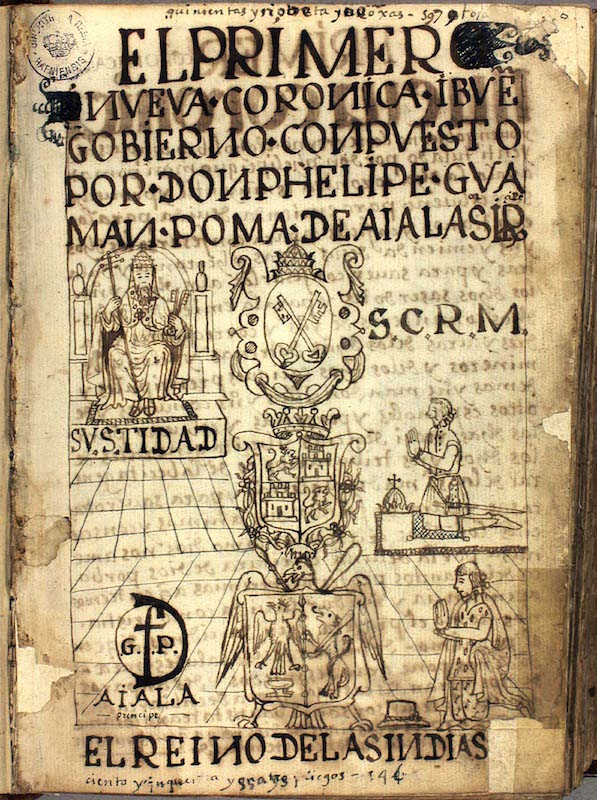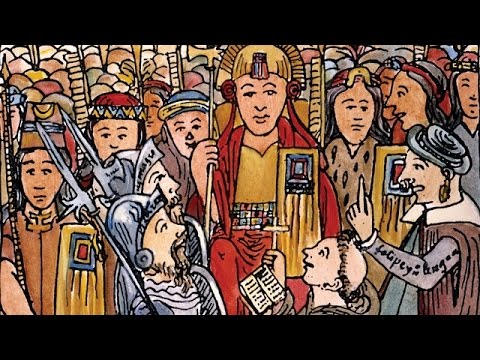How Was The Requerimiento Used?
The document was designed to be read aloud during a legal ceremony that historian Samuel Dickenson has aptly summarized. The exact legalities that were required for each reading of the Requerimiento: “The commander of a Spanish force was ordered without fail the Requerimiento be read to the Indians at least three times before proceeding against them. A notary was to make note of it, and at least one priest was to serve as a witness.” Muldoon’s research recounts Spaniards mumbling the necessary words into their beards, reading the text on board ships that have yet to make landfall and in campgrounds during nights prior to attacks. There are even some historical accounts of Spaniards crumpling up and throwing the Requerimiento at the backs of fleeing indigenous in order to satisfy their legal requirement before beginning a “just” war But the circumstances that surround the way the requirement was actually used have been the subject of study by scholars such as . The legal proceedings and social performance that accompanied the document reveal key insights about the culture of Spanish colonialism. According to historian James Muldoon, the original translation of the document from its original Latin to Spanish was given to Francisco Pizzaro to be used during conquest of Peru, and Subsequent copies of the Requerimiento accompanied every prominent conquistador. Some of history's most infamous and, indeed, controversial figures are said to have used El Requerimeinto as part of their ceremonies of possession: Hernando De Soto, Herman Cortez, and Francisco Vasquez de Coronado all carried copies of the document The Requerimiento was not abolished until 1566 The document itself implies that its reader should give the indigenous enough time to “Deliberate upon this.” The Requerimiento reads, “Wherefore, as best we can, we ask and require you that you consider what we have said to you, and that you take the time that shall be necessary to understand and deliberate upon it. The Requiremento was designed as a text to be read, translated, and relayed in an intelligible manner to the indigenous peoples it was designed to protect, but functioned more as a symbolic object—a superficial tool of formality that allowed the Spanish to “proceed against” their enemies with perceived impunity. Not surprisingly, there is nothing in the document that states how long that deliberation time may be. So while the witnesses are being asked to perform their part of the ceremony by “deliberating” their participation in this performance was, in reality, unnecessary. This performance also requires particular temporal and spatial registers for it to be “just.” But in an account of a skirmish between Caribs and the conquistador Hernando De Soto’s party, for example, the accompanying friars were said to have quickly read the requiremento aloud three times—the exact number needed in order to promote a just war—but did so far, far away from the skirmish so as to not be caught in a volley of arrows Understanding textual artifacts such as el Requerimiento in terms of both archival objects and ceremonial objects accompanied by a repertoire allows us to better understand that literature is often a tool of conquest. These symbols of power, however, are just that—symbols. They depend upon a cultural “buying-in” and a subsequent reification of said cultural symbol. In any event, the object that is the requiremento of 1513 achieved two simultaneous outcomes: it instilled a sense of Iberian authority while also affirming that the mission of the conquests was a “just” one.
The Performance of El Requerimiento
Much has been said about the use of the document as an object, but much more needs be said about the performance that the document permitted. Diana Taylor argues that Repertoire is an equally effective means of transmitting knowledge. Repertoire, Taylor writes, “enacts embodied memory: performances, gestures, orality, movement, dance, singing—in short, all those acts usually though of as ephemeral, non-reproducible knowledge. Taylor uses performativity theory, which is a widely accepted concept that suggests that certain speech constitutes action, to argue for a reexamination of epistemological dissemination in the Americas.
By using Taylor’s view of performativity and Repertoire as an alternate approach to understanding the archival function of the Spanish Empires bureaucracy, we can see the Requerimiento simultaneously functioning as an object whose power lies both in its ability to be archived and performed. the Requerimiento’s accompanying guidelines encourage a translation but do not require it. This meant that so long as it was read to the natives, friars and captains could read the text in any language they thought best. And in an era where most communication is done through signs and gesticulations one can imagine the absurdity of being read to in a foreign language before being attacked.
Similarly, Patricia Seeds book Ceremonies of possession hints at the fact that ceremonies were of great importance to the Spanish colonials.
Paja Faudree, for example, argues that “[El Requerimiento] explicitly circumscribes the speaker’s responsibility for the speech event, minimizing the importance of the identity of the particular speakers reciting the document” and that what truly matters in this ceremony is the document itself. The object, thus understood, carries more power than its speaker.
But who, Faudree argues, were the actual witnesses and participants in this legal ceremony? And considering the issues of translation and the privileging of alphabetic literacies, how was this ceremony conveyed to the indigenous?


El Requerimiento's use as an Object
The text of the Requerimiento is not nearly as vital to the success of Spanish imperialism as the physical presence of the textual object itself. So long as the text was "at hand" the exact legalities could be fulfilled. It is also worth noting that not all of the Spanish conquerors were literature, but whether or not a one was capable of reading the text made no difference, the object held values that were respected by those who could understand the social contexts it subsumed
Book Historian, Miles Ogborn, argues that a employing a material approach to the history of texts “can demonstrate the fragility of that power and the uncertainty of knowledge, as well as show the ways in which both could become, through processes of inscription and reinscription, solidified into institutional routines and forms of rule.” The document, being less than 1,000 words long, was certainly capable of traveling far and wide so long as it was well preserved and protected from the elements. To date, no extant research has been conducted on the ways in which El Requerimiento's physical copies were created, disseminated, or utilized.
Some believe that the document was literally crumbled up and thrown at indigneous poples. But a consideration of the effort needed to obtain the document’s medium materials, commission a drafter, protect the completed object in the microclimates of a ship, and then travel from the ship to Terra Firma only to throw the object at an indigenous person renders this and other scenarios as highly improbable.
Works Cited
Dickinson, Samuel Dorris. "De Soto and the Law." The Arkansas Historical Quarterly 49, no. 4 (1990): 297-312.
Juan Lopez Palacios Rubios Coleción de documentos (1971).
Mignolo, Walter D. “The Darker Side of the Renaissance: Colonization and the Discontinuity of the Classical Tradition” Renaissance Quarterly, vol 45, No. 4. (1992).
Taylor, Diana. The Archive and the Repertoire: Performing Cultural Memory in the Americas. Durham: Duke University Press Books, 2003.
Weckmann, Luis The medieval heritage of Mexico. Fordham University Press, New York, 1992.
Secondary Bibliography
Paja Faudree. “Reading the Requerimiento Performatively: Speech Acts and the Conquest of the New World” Colonial Latin American Review, 24:4, 456-478. (2015)
---- “How to Say Thing with Wars: Performativity and Discursive Rupture in the Requerimiento of the Spanish Conquest” Linguistic Anthropology, 22:3, 182-200 (2013)
Lewis Hanke. “The Requerimiento and its Interpreters” Revista de Historia de America. Vol 1. 25-34 (1938)
Muldoon, James. John Wyclif and the rights of the infidels: the requerimiento re-examined. Washington University Press. (1980)
